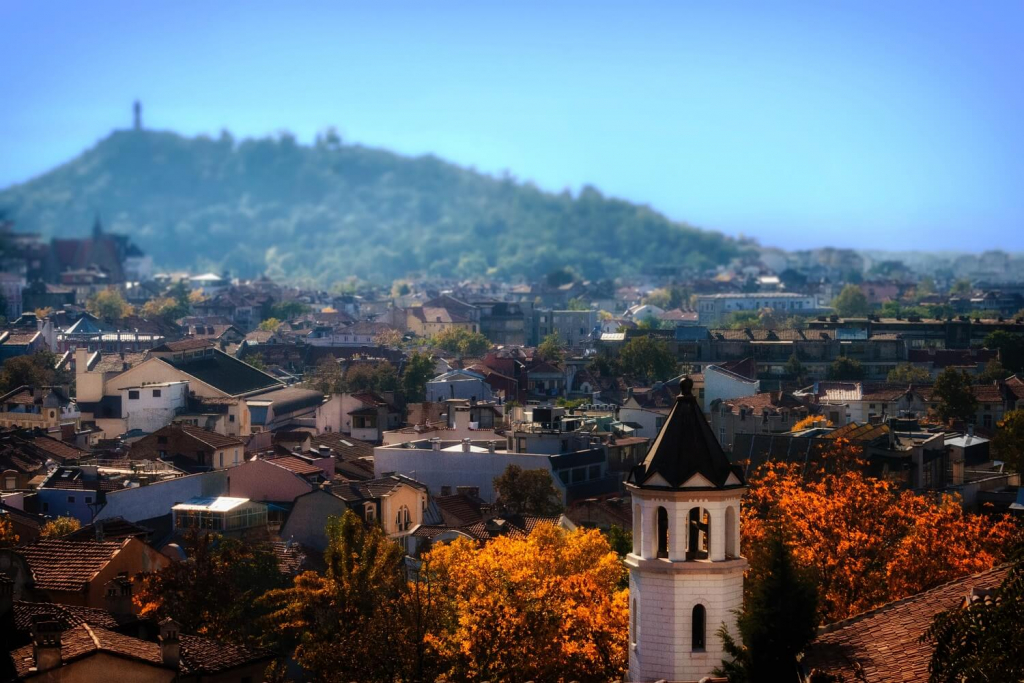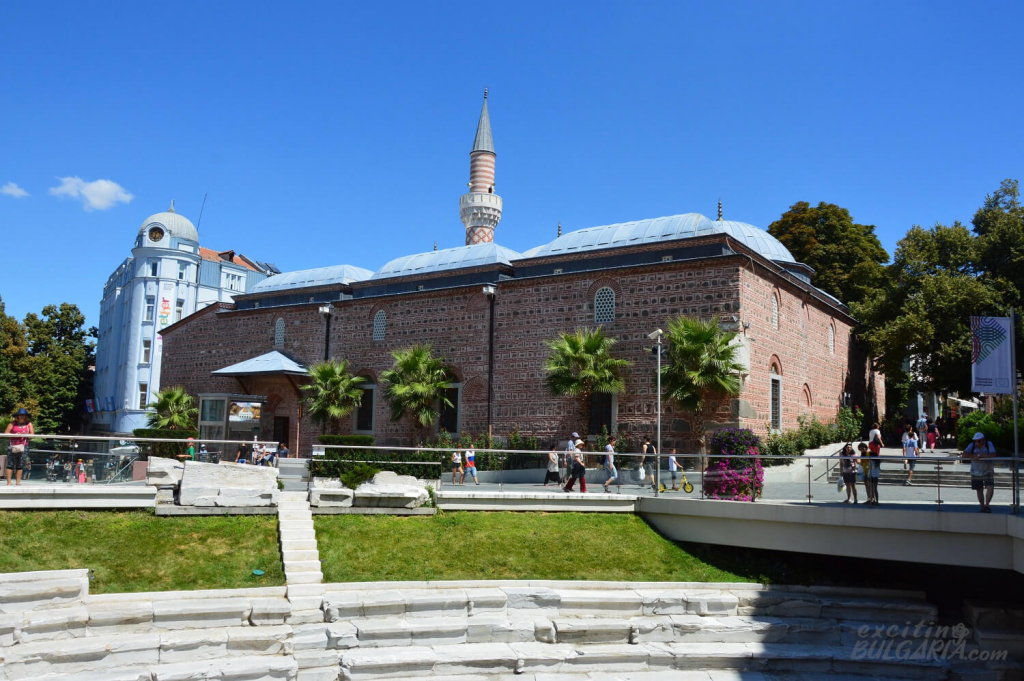Last updated on 5 October 2021
Plovdiv is the second largest city of Bulgaria with a population of 347 000, also considered as the country’s cultural capital. It is supposedly the oldest continuously inhabited city in Europe with many well preserved ancient monuments. The city was selected as the European Capital of Culture for 2019.

With its ancient remains, beautiful old town and cultural events, Plovdiv is a great tourist attraction on its own. When asked, most Bulgarians will probably advise you to visit Plovdiv rather than Sofia. The sights are all located in the city center, walking around for a few hours will let you explore the most important parts.
Plovdiv can also serve as a nice base for visiting sites in the Rhodope mountains, such as the Bachkovo Monastery or the ski resort of Pamporovo.
Location
Plovdiv (BG: Пловдив) is located on the banks of the Maritsa river, 150 km southeast from Sofia. It lies in a valley between the Balkan and Rhodope mountains at the foothills of the latter. Plovdiv is referred to as “The City of the Seven Hills” because originally it was founded on seven rocky hills. Today they are only six as one of them was destroyed in the early 1900s.

If you are visiting in the summer, be prepared for very hot and dry days with temperatures well above 30 °C. Winters are usually cold and snowy.
History
Plovdiv is not just allegedly the oldest city in Europe but also one of the oldest cities in the world. The first traces of habitation in the area date back to 8000 years ago. The fort was established by Thracians between the 2nd and the 1st millennium BC. Founded by Philip the Great as a city (polis) in the 4th century BC, the settlement was named Philippopolis. In 46 AD, it became part of the Roman Empire. Philippopolis developed into the most important city (and capital) of the Roman Province of Thrace with public buildings and baths, theaters and a stadium. It is the only city in the region with an advanced ancient water supply system and sewerage.
Plovdiv was first incorporated into the Bulgarian Empire in the 9th century. After some Byzantine possession, it was eventually conquered by the Ottomans in the 14th century. Their rule lasted for more than 500 years, during this period the city was renamed to Filibe.
Plovdiv served an important role in the Bulgarian unification and rejoined Bulgaria in 1885.
What to see in Plovdiv
Old town
On the hills called Nebet Tepe, Dzhambaz Tepe and Taksim Tepe, GPS: 42.149960, 24.752781

Located on three of Plovdiv’s hills, the old town is the city’s main tourist destination and a beautiful place for walks. It has a wonderful atmosphere thanks to the mixture of architecture where buildings from antiquity, the middle ages and the Bulgarian revival period coexist. The emblematic houses like Balabanov or Kuyumdzhiev were built in the 19th century when Plovdiv became an important economic center. The rich merchants of the city showed their wealth by building gorgeous, fancily decorated houses. The architectural and historical reserve is being considered for nomination to the UNESCO World Heritage list.

Ancient theater
BG: Античен театър, 4 Tsar Ivaylo street, GPS: 42.147217, 24.751488
The Ancient theater of Philippopolis is one of the best-preserved ancient theaters in the world. It is the symbol of Plovdiv and the most famous construction from the Roman times in Bulgaria. The theater was built in the 1st century AD and is currently in use. In the summer months, it hosts theatrical plays, concerts and various cultural events and can currently accommodate about 3500 spectators. It is located in the Old town, in a natural saddle between two of the hills, Dzhambaz and Taksim. The theater is open to the public every day between 9:00 and 18:00 (17:30 during winter), the entry ticket costs 5 BGN.
Hisar Kapia gate
BG: Хисар капия, Hisar Kapia Square, between streets Doctor Stoyan Chomakov and Tsanko Lavrenov, GPS: 42.149783, 24.753117

Hisar Kapia is a medieval gate in the old town of Plovdiv and one of the landmarks of the city. It is the eastern entrance of the ancient settlement. The gate got its current form around the 13th century but the foundations are from the Roman times.
Ancient stadium
BG: Античен стадион, Rimski Stadion Square, at the northern end of Knyaz Alexander I Street, GPS: 42.147665, 24.748060
This large Roman stadium, built approximately in the same time as the theater, could seat up to 30000 people. Its northern curve with the solid marble block seats has been restored and is now visible next to the Dzhumaya Mosque. The rest of the construction is buried under the main pedestrian street. It is one of the biggest buildings in the Balkan peninsula from the Roman times with an original length of about 240 m.
Main street
BG: Главна улица / Главната, Central Square, Knyaz Alexander I Street, Rayko Daskalov Street, Brezovska Street
Plovdiv’s pedestrian street, often referred to as „The Main”, is actually a combination of streets that results in the longest pedestrian zone in Europe with a length of almost 1.8 km. Housing galleries, shops, restaurants, bars and cafés, The Main is a landmark itself with its fabulous 19th-century buildings.
The street starts from Central Square, next to the forum of Roman Philippopolis. It continues next to the fountain referred to as „the buttons” (named after the seats around it) until it reaches the Ancient stadium. The street continues from the other side of the remains and ends after crossing the Maritsa river through a pedestrian bridge.
Tsar Simeon’s Garden
BG: Градина Цар Симеон, GPS: 42.140512, 24.745829

Tsar Simeon’s Garden is a large public park in the center of Plovdiv. Considered as a masterpiece, the recently renovated garden accommodates a lake, a pavilion, fountains and many sculptures. The main attraction of the park is the Singing Fountains, providing a 25-minute artistic lighting show including 5 music tracks that vary weekly. The spectacle is scheduled at 21:30 (20:30 during winter) on Thursdays, Fridays and Saturdays.
Kapana district
BG: Капана, GPS: 42.149279, 24.748863

Since at least the 15th century, Kapana was the commercial heart of Plovdiv with hundreds of craft shops until a huge fire destroyed most of it in 1906. The area was ignored for almost a century until recently. It has been nicely refurbished by 2015 and transformed into a vibrant, modern-day creative district loaded with cafés, bars and restaurants.
Events
Plovdiv is deemed to be Bulgaria’s cultural capital for a good reason. The city hosts a large variety of cultural events annually, such as theatrical and TV festivals, Opera Open, NIGHT/Plovdiv, Kapana Fest and the International Fair Plovdiv. It is also a literary center, has a philharmonic orchestra and around 40 art galleries.
Transportation
Plovdiv can be reached in less than 2 hours from Sofia on highway A1 (called Trakia). Even if you didn’t plan a visit, it’s absolutely worth to stop for at least a few hours before heading to the seaside. Paid parking areas are available in the city center for 2 BGN per hour.
Buses from Sofia depart every half hour. The route is served by several companies such as Karat-S, Union Ivkoni, Hebros, Arda Tur and Vitosha Express. The ride takes a bit more than two hours and costs around 15 BGN.
Trains are also available from Sofia. They’re slightly cheaper (around 13 BGN) but a bit slower too as the trip takes two and a half hours.
Plovdiv has a small international airport located just 13 km from the city center. It mainly serves ski tourism charter flights but there are scheduled ones as well from/to London Stansted, Moscow and Tel Aviv. Be aware that there is no regular public transport between the city center and the airport. The taxi fare is around 15 BGN.



